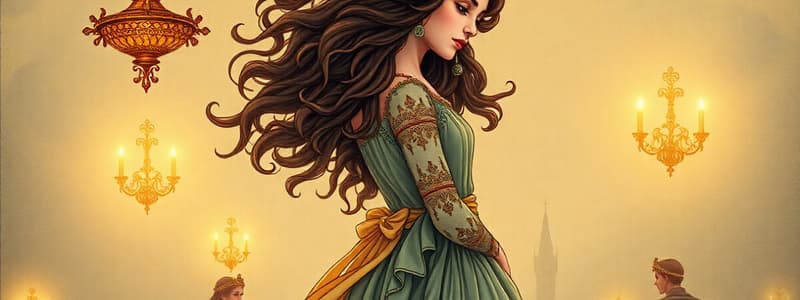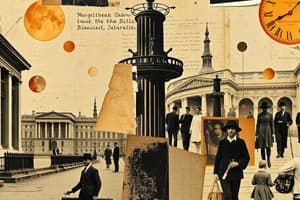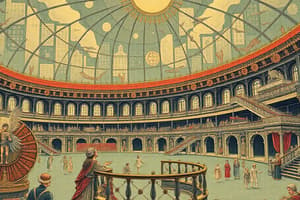Podcast
Questions and Answers
What was Kant's view on the role of education regarding a child's impulses?
What was Kant's view on the role of education regarding a child's impulses?
- It needed to guide and discipline impulses into rational behaviors. (correct)
- It should only focus on moral teachings.
- It should let impulses run wild to foster creativity.
- It had no significant role in shaping behavior.
What innovative feature did Johann Bernhard Basedow implement at the Philantropinum school?
What innovative feature did Johann Bernhard Basedow implement at the Philantropinum school?
- A strict curriculum with no room for physical activities.
- Admission of students regardless of gender and social status. (correct)
- Educating only children from affluent families.
- A focus exclusively on academic activities.
What did Basedow prioritize in the curriculum of the Philantropinum school?
What did Basedow prioritize in the curriculum of the Philantropinum school?
- Emphasis on academic activities only.
- An equal split between physical and intellectual activities. (correct)
- Physical activities over intellectual pursuits.
- Only manual labor training for all students.
Which aspect of Johann Friedrich Simon's methodology was remarkable at the Philantropinum school?
Which aspect of Johann Friedrich Simon's methodology was remarkable at the Philantropinum school?
What was Basedow's reason for resigning from his position as director of the Philantropinum?
What was Basedow's reason for resigning from his position as director of the Philantropinum?
What type of physical activities were introduced by Johann Friedrich Simon in the curriculum?
What type of physical activities were introduced by Johann Friedrich Simon in the curriculum?
In what year did Basedow establish the Philantropinum school?
In what year did Basedow establish the Philantropinum school?
What happened to the Philantropinum school after Basedow's death?
What happened to the Philantropinum school after Basedow's death?
What was a significant outcome of the unilateral reforms during the absolute monarchy?
What was a significant outcome of the unilateral reforms during the absolute monarchy?
Which movement emphasized the importance of direct experience with nature for children's development?
Which movement emphasized the importance of direct experience with nature for children's development?
How did enlightened education view the accessibility of education during the 18th century?
How did enlightened education view the accessibility of education during the 18th century?
What did the rationalist movement primarily advocate for?
What did the rationalist movement primarily advocate for?
Which notable author is associated with the naturalist movement?
Which notable author is associated with the naturalist movement?
What role did Physical Education play in the context of enlightened education?
What role did Physical Education play in the context of enlightened education?
Which pedagogical movement aligned closely with naturalism but was more structured?
Which pedagogical movement aligned closely with naturalism but was more structured?
What was a characteristic of the educational transformation during the 18th century?
What was a characteristic of the educational transformation during the 18th century?
What did naturalism advocate for in education?
What did naturalism advocate for in education?
What did Rousseau believe was essential for a child's development?
What did Rousseau believe was essential for a child's development?
In Rousseau's view, what is the effect of civilization on humanity?
In Rousseau's view, what is the effect of civilization on humanity?
Which of the following is NOT a focus during the first stage of education according to Rousseau?
Which of the following is NOT a focus during the first stage of education according to Rousseau?
What type of exercises did Rousseau consider superior for children?
What type of exercises did Rousseau consider superior for children?
Which author is associated with the concept of the 'Natural Method' in education?
Which author is associated with the concept of the 'Natural Method' in education?
How many life stages does Rousseau divide education into?
How many life stages does Rousseau divide education into?
What was Rousseau's stance on schools in relation to children's education?
What was Rousseau's stance on schools in relation to children's education?
What characterized the Enlightenment period?
What characterized the Enlightenment period?
Who were the French Encyclopedists?
Who were the French Encyclopedists?
What is Enlightened Despotism?
What is Enlightened Despotism?
What was a significant social change during the Enlightenment?
What was a significant social change during the Enlightenment?
What was the main belief of Enlightenment thinkers about society?
What was the main belief of Enlightenment thinkers about society?
What was the relationship between the Enlightenment thinkers and monarchs?
What was the relationship between the Enlightenment thinkers and monarchs?
What did Enlightened Despotism aim to achieve?
What did Enlightened Despotism aim to achieve?
What role did cafes play during the Enlightenment?
What role did cafes play during the Enlightenment?
What is the primary focus of the fourth stage of development (ages 15-20)?
What is the primary focus of the fourth stage of development (ages 15-20)?
Which philosopher emphasized the importance of the social environment in human development?
Which philosopher emphasized the importance of the social environment in human development?
What did Helvétius recommend regarding physical education in schools?
What did Helvétius recommend regarding physical education in schools?
At what age does the second stage of development focus on exploration and learning through experience?
At what age does the second stage of development focus on exploration and learning through experience?
How does Kant’s approach to education differ from Rousseau’s perspective?
How does Kant’s approach to education differ from Rousseau’s perspective?
What key aspect of education does the third stage (ages 12-15) primarily address?
What key aspect of education does the third stage (ages 12-15) primarily address?
Which of the following best describes the purpose of the fifth stage of development (20 years and onward)?
Which of the following best describes the purpose of the fifth stage of development (20 years and onward)?
What concern did Helvétius express regarding education among the European elite?
What concern did Helvétius express regarding education among the European elite?
What was one main concern Jovellanos had regarding public entertainments?
What was one main concern Jovellanos had regarding public entertainments?
What role did sports associations play in the development of modern sports in the 19th century?
What role did sports associations play in the development of modern sports in the 19th century?
Who primarily formed the first sports clubs and societies in England?
Who primarily formed the first sports clubs and societies in England?
What was a significant factor that enabled the expansion of sports during the 19th century?
What was a significant factor that enabled the expansion of sports during the 19th century?
How did modern boxing evolve in the 18th century?
How did modern boxing evolve in the 18th century?
What was the main purpose of creating regulations in early sports associations?
What was the main purpose of creating regulations in early sports associations?
What aspect of public entertainments did Jovellanos emphasize was crucial for the community?
What aspect of public entertainments did Jovellanos emphasize was crucial for the community?
Which of the following sports became codified due to the influence of early sports associations?
Which of the following sports became codified due to the influence of early sports associations?
Flashcards
Naturalism in Education
Naturalism in Education
A philosophical and cultural movement that emphasized nature as the foundation of all knowledge and reality.
Rationalism in Education
Rationalism in Education
A movement that advocated for the use of reason as the primary tool for understanding the world and achieving truth.
Philanthropism in Education
Philanthropism in Education
A pedagogical movement that aimed to restructure education by incorporating naturalism with a more structured approach.
Education
Education
Signup and view all the flashcards
Physical Education
Physical Education
Signup and view all the flashcards
Enlightenment
Enlightenment
Signup and view all the flashcards
Universal Education
Universal Education
Signup and view all the flashcards
Naturalistic Education
Naturalistic Education
Signup and view all the flashcards
The Enlightenment
The Enlightenment
Signup and view all the flashcards
What was the Enlightenment a response to?
What was the Enlightenment a response to?
Signup and view all the flashcards
Who were the key figures of the Enlightenment?
Who were the key figures of the Enlightenment?
Signup and view all the flashcards
Enlightened Despotism
Enlightened Despotism
Signup and view all the flashcards
Reason
Reason
Signup and view all the flashcards
Merit
Merit
Signup and view all the flashcards
Pursuit of Progress
Pursuit of Progress
Signup and view all the flashcards
What were the key reforms of the Enlightenment?
What were the key reforms of the Enlightenment?
Signup and view all the flashcards
Second Stage (5-12 Years): Exploration
Second Stage (5-12 Years): Exploration
Signup and view all the flashcards
Third Stage (12-15 Years): Intellectual Education
Third Stage (12-15 Years): Intellectual Education
Signup and view all the flashcards
Fourth Stage (15-20 Years): Moral Education
Fourth Stage (15-20 Years): Moral Education
Signup and view all the flashcards
Fifth Stage (20 years and onward): Society and Family
Fifth Stage (20 years and onward): Society and Family
Signup and view all the flashcards
Helvetius's Educational Philosophy
Helvetius's Educational Philosophy
Signup and view all the flashcards
Helvetius's View on Physical Education
Helvetius's View on Physical Education
Signup and view all the flashcards
Kant's Approach to Education
Kant's Approach to Education
Signup and view all the flashcards
Kant's Interpretation of Rousseau
Kant's Interpretation of Rousseau
Signup and view all the flashcards
Kant's view on education
Kant's view on education
Signup and view all the flashcards
Physical education in Kant's philosophy
Physical education in Kant's philosophy
Signup and view all the flashcards
Who was Johann Bernhard Basedow?
Who was Johann Bernhard Basedow?
Signup and view all the flashcards
What was unique about the Philantropinum?
What was unique about the Philantropinum?
Signup and view all the flashcards
What was the curriculum like at the Philantropinum?
What was the curriculum like at the Philantropinum?
Signup and view all the flashcards
Who was Johann Friedrich Simon?
Who was Johann Friedrich Simon?
Signup and view all the flashcards
What did the Philantropinum's physical education program include?
What did the Philantropinum's physical education program include?
Signup and view all the flashcards
Why did the Philantropinum shut down?
Why did the Philantropinum shut down?
Signup and view all the flashcards
Natural Education
Natural Education
Signup and view all the flashcards
Natural Method
Natural Method
Signup and view all the flashcards
Civilization Corrupts Children
Civilization Corrupts Children
Signup and view all the flashcards
Importance of Free Play
Importance of Free Play
Signup and view all the flashcards
Emile, or On Education
Emile, or On Education
Signup and view all the flashcards
First Stage of Education (0-5 years)
First Stage of Education (0-5 years)
Signup and view all the flashcards
Child's Innate Goodness
Child's Innate Goodness
Signup and view all the flashcards
Five Stages of Education
Five Stages of Education
Signup and view all the flashcards
Sports Associationalism
Sports Associationalism
Signup and view all the flashcards
Sports Clubs and Societies
Sports Clubs and Societies
Signup and view all the flashcards
Codification of Sports Rules
Codification of Sports Rules
Signup and view all the flashcards
Formalized Competitions
Formalized Competitions
Signup and view all the flashcards
Construction of Sports Venues
Construction of Sports Venues
Signup and view all the flashcards
Modern Boxing
Modern Boxing
Signup and view all the flashcards
Fair Play
Fair Play
Signup and view all the flashcards
Evolution of Early Sports
Evolution of Early Sports
Signup and view all the flashcards
Study Notes
Enlightenment and History of Sports
- The Enlightenment, also known as the Age of Reason, spanned the late 17th to 1789.
- It prioritized reason, critical thinking, scientific application, and progress.
- This period reacted to the rigidity of Ancien Régime society and was driven by economic growth, international trade, and the Scientific Revolution.
- This led to new ways of understanding the world, focusing on knowledge, education, and social advancement.
- A new intellectual elite arose, advocating for societal transformation through reason and merit.
- Notable figures of this group include the French Encyclopedists like Diderot, D'Alembert, Voltaire, and Rousseau.
- These intellectuals often met in academies, societies, or cafés discussing and disseminating ideas.
- Enlightenment thinkers influenced monarchs to implement reforms to improve society, although maintaining absolute power.
- Reforms focused on the economy, public administration, justice, and education.
Enlightened Despotism
- Enlightened Despotism was a new form of government, aiming to modernize and improve society.
- It sought to reconcile absolute monarchical authority with Enlightenment ideals.
- Monarchs, believing they were serving the people's best interests, implemented reforms but without ceding power.
- While reforms brought progress, participation from the people was not included in the decision-making.
- These reforms impacted the economy, administration, justice, and education systems, but still maintained a hierarchical structure.
Physical Education in the Enlightenment
- Education significantly changed during this era, seen as vital for societal well-being.
- The debate shifted towards making education accessible to a wider range, not just the elite or religious groups.
- Emphasis was placed on the holistic development of individuals, emphasizing physical education as a fundamental aspect.
- Physical education was considered crucial for shaping character, health, and morality.
Enlightened Education
- Education underwent a profound transformation thanks to advancements in knowledge, reason, and progress.
- Educators sought to promote reason and critical thinking in instruction.
- Enlightened thought valued accessible education for all members of society.
- Major movements like naturalism, rationalism, and philanthropism emerged, which were integrated into philosophies of education.
Notable Thinkers and Educators
- Jean-Jacques Rousseau: Advocated for a "Natural Method" (Natural Education) in which children learn in a way that is spontaneous and in contact with nature. He believed that civilization corrupts humanity.
- Claude Adrien Helvétius: Emphasized the importance of the environment and social experience in shaping individual development. He also advocated for greater emphasis on physical exercise.
- Immanuel Kant: Believed that education should focus on developing reason and morality, not just respecting natural impulses. He viewed physical education as a means to achieve discipline, control over instincts, and the ability to become moral beings.
- Johann Bernhard Basedow: Implemented Enlightenment ideas in a real educational setting with the founding of the Philantropinum school. He integrated physical education into his curriculum.
- Johann Friedrich Guts Muths: Founded various manuals and developed a methodical approach to gymnastics. He highlighted the importance of physical education and self-improvement in the development of individuals.
- Johann Heinrich Pestalozzi: Emphasized holistic education encompassing the mind, body, and spirit. He incorporated physical education and manual labor into his curriculum and promoted values like camaraderie, cooperation, respect, and empathy in his educational method.
- Gaspar Melchor de Jovellanos: Advocated for reforms in the Spanish educational system, emphasizing universal accessibility, morality, civic education, and physical education.
Sport and Associationalism
- The development of sports associations was linked to shared sporting interests.
- Initially, sports associations and clubs were established by aristocrats and the bourgeoisie who used them for social networking, leisure, and strengthening social ties.
- These developments paved the way for the formal rules of sports practices that were initially dispersed across various communities and regions for activities.
- Rules standardization was crucial in the formation of sports organizations and competitive sporting events.
- Expansion led to the development of sports venues and public spaces for sporting activities.
Boxing
- Modern boxing evolved in 18th-century England, transitioning from a noble duel to a regulated sport.
- It involved the implementation of rules increasing awareness and popularity.
- Key figures like James Figg standardized the sport and popularized it.
- Professionalization and attracting larger audiences played a significant role that increased spectator interest.
- Boxers and promoters had a wide social appeal, from the working class to the nobility.
Cricket
- Cricket, although having earlier roots, developed extensively in the 18th-century England. Formalization of rules, establishment of clubs, and increased spectator interest all contributed to its development.
- Cricket clubs played a significant role in codifying rules and organizing the structure of the sport.
- The presence of women in cricket matches further highlighted its growth and popularity during the time.
Pedestrianism
- Pedestrianism, or footraces, gained prominence in the 18th century in England, often attracting high-stakes betting.
- Initially for footmen, servants, and aristocratic individuals, the popularity of the sport spread to various social classes.
- Notable feats like long-distance running events further attracted considerable interest and betting opportunities.
- Pedestrianism demonstrated the blending of sports, gambling, and public entertainment.
Studying That Suits You
Use AI to generate personalized quizzes and flashcards to suit your learning preferences.
Related Documents
Description
Explore the transformative period of the Enlightenment and its influence on sports and society. This quiz covers key figures, social changes, and the importance of reason and education during this significant era. Test your knowledge on how Enlightenment ideas shaped modern sports and culture.




